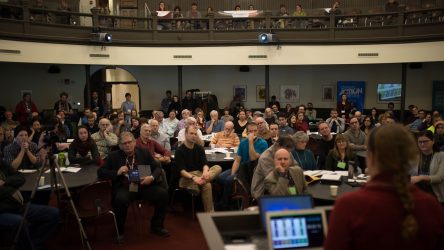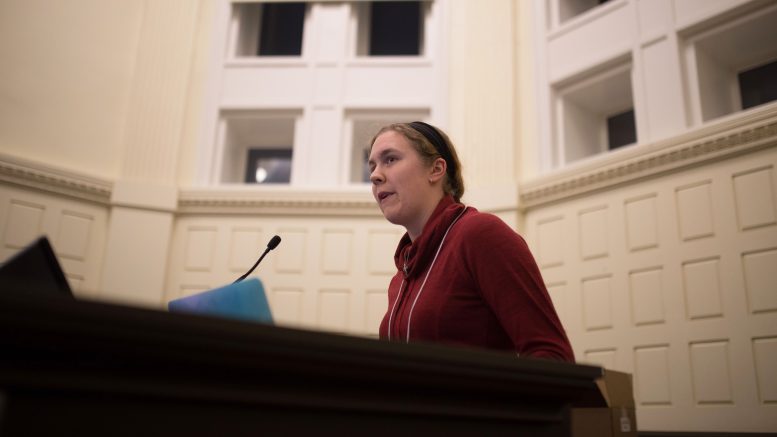Manitoba Eco-Network, alongside organizations such as Climate Change Connection, Manitoba Energy Justice Coalition, and Wilderness Committee, gathered for a town hall to discuss the province’s five-year Made-in-Manitoba Climate and Green Plan at the University of Winnipeg Nov. 28.
The plan, which claims to make Manitoba the “cleanest, greenest and most climate resilient province,” names four specific pillars which the province intends to focus on to achieve this goal: climate, jobs, water, and nature.
Climate
Curt Hull, project manager for Climate Change Connection, discussed climate and jobs and provided insight on some of the actions the provincial government hopes to take regarding these two sectors.
Climate Change Connection focuses on climate change in two ways: education and solution.
“We work with teachers, and schools, and students, and young people, and businesses. We give presentations to anybody to listen to us. And then we also work on solutions,” Hull said.
“When it comes to solution, we work at varying depths in all of the sectors associated with climate change solutions.”
“We work with transit, we work with the provincial government in the sustainable development department, renewable energy, hydro, we work with agriculture, we work with First Nations, we work with all kinds of people,” he added. “As many aspects of solution as we can think of or are aware of, we get involved with in some way.”
Each of the four pillars outlined in the plan is further supported by four keystones: clean energy, carbon pricing, sector emissions reductions, and adaptation.
Hull said that of the four keystones supporting the climate pillar, the most important is carbon pricing, which he said will generate the revenue needed to support other building blocks.
Beginning next year, the provincial government plans to implement a $25 per tonne carbon tax that will remain at $25 for the course of the five-year period. This move stands in contrast to Ottawa’s timeline for carbon pricing, which mandates provinces to introduce a minimum $10 per tonne carbon tax beginning in 2018, an amount which must increase to $50 per tonne by 2022.
Hull said he was “ecstatic” about the province’s move to put a price on carbon emissions, referring to the move as an “essential step” to dealing with climate change and moving away from “our dependence on fossil fuels.”
Hull added that the provincial government’s decision to follow a different route on carbon pricing grew out of the province’s belief that more revenue could be realized in the beginning of the five-year plan that could then be used for further reductions in fossil fuel emissions.
However, Hull expressed concern regarding the effectiveness of the provincial government’s plan compared to the federal government’s plan five years from now.
“Personally, I’m concerned about what happens after five years. That’s my caution,” he said. “I can accept that argument, but then after five years the federal government is going to be twice as much as we are. Will there be a shock to our system when we try to catch up?”
Jobs
Hull noted that addressing issues concerning climate change would open doors to more job opportunities in the process.
“If we effectively address climate, we’re also going to be reaping benefits in terms of jobs because there’s a lot of work to be done here and people should be paid for the work that’s required,” he said.
Speaking on how to make the province the most climate resilient, Hull said this involved satisfying our basic needs of water, food, transportation, and shelter without relying on fossil fuel. This, he said, can be achieved by creating climate jobs.
“Starting with food, more local food. We’re an agricultural province but we’re an agricultural exporting province,” he said. “We export stuff then we bring it back processed.”
“Ultimately, we’ve got to get to a point where we stop expanding the natural gas distribution system.
“When it comes to transportation, there’s all kinds of aspects to this, but one of the most important when it comes to jobs as a benefit here, electrification of our transportation system,” he added. “There’s lots of jobs and opportunity that comes from that.”
Water
Candi Bezte, water program manager with Manitoba Eco-Network, addressed the plan’s water pillar and gave an explanation on how water supply could be affected in the future.
“The Prairie Climate Centre has got some information out there showing that we’re going to get a lot more water when we don’t necessarily want it, and we’re going to have a lot less water when we actually need it,” she said. “And so they do recognize that water distribution and storage is going to be a huge issue for us in the future as far as agriculture.”

Winnipeggers gather in Convocation Hall at the University of Winnipeg on November 28 for a town hall on climate action. Representatives from organizations like the Green Action Centre, Manitoba Eco-Network, and Manitoba Wetlands spoke about potential green climate action.
The Prairie Climate Centre aims to make climate change meaningful and relevant to Canadians by explaining and communicating future impacts of cliamte change through maps, videos, reports, and web content.
Bezte also added that water was “the great connector” in the sense that land use practices had direct impacts on water supply. She said that this was important to note, given that our water retention capacity has decreased by a considerable amount over the years.
With regards to water treatment in the province, Bezte said that a lot more data collection is required before attempting to address the issues in the province and implementing the Climate and Green Plan regarding the water pillar.
Nature
Eric Reder, the Manitoba campaign director for the international NGO Wilderness Committee, emphasized the importance of maintaining a functioning ecosystem through conservation, and how this impacts on other pillars of the Climate and Green Plan.
“We need conservation because functioning natural ecosystems, wilderness, nature, those are the things that support all the pillars,” he said. “Everything that we work on is inside functioning natural ecosystems. Our water, our climate, it gives us our healthy communities, and nature is the thing that we have to pay attention to.”
Reder said that although no specific target had been set with respect to nature conservation, “jurisdictions around the world have agreed on the target of 17 per cent protected area by 2020.”
However, Reder noted that the plan is limited, insofar as there are many important groups, such as Indigenous communities, whose voices were excluded.





